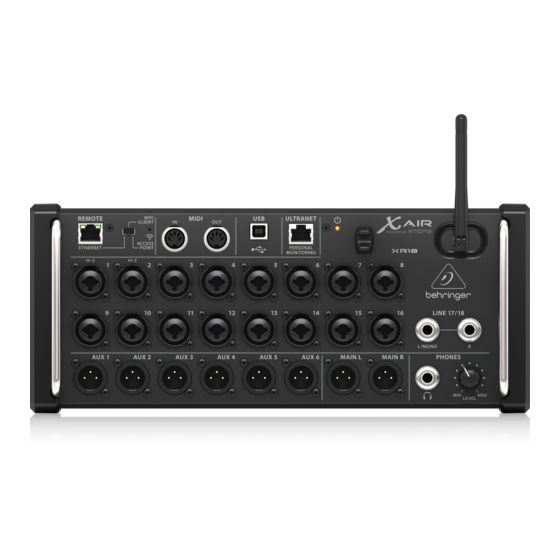
Advertisement
Quick Links
Manual for changing/controlling audio settings of specific research lab's at the DCC.
Set up audio recording labs.
The sound recording and EEG labs have been equipped with a setup that enables to present audio
stimuli, to record audio responses, to make stimulus recordings and to monitor the quality of the stimuli
and responses.
The mixer that is used for this is the Behringer Xair18.
This is a professional mixer with 18 analog mono inputs,
10 analog mono outputs, Midi in and out, USB connection
for audio-in-out and control, Ethernet for control and
additional features.
The Behringer is controlled by a program built by the TSG called 'Beer'. Beer enables researchers to set
and store settings for specific experiments. These specific settings have to be loaded at the start of each
new measurement session ensuring that these stay identical throughout all experiment sessions.
PC
Control of the Behringer via 'Beer'.
-How to use Beer.
The 'Beer' program expects the default TSG settings and the devices to be switched on. The 'Beer'
program is based on Python and will run on our FSW/DCC/BSI research labcomputer
(Start\All_Programs\Behringer).
The available input devices are:
Subject1-microphone. (mono)
Subject2-microphone. (mono)
PC output audio line-out. (stereo)
Behringer-1-setup TSG
PC Line OUT-R
Behringer Input-4
PC Line OUT-L
Behringer Input-3
PC Line IN-R
Behringer AUX-2
PC Line IN-L
Behringer AUX-1
Extra UTP Card in PC connection
IP: 192.168.1.101
USB 2.0 to USB PC connection
Phones Exp-R
Behringer Control-R
Phones Exp-L
Behringer Control-L
Behringer
Radboud University Nijmegen. FSW/TSG june 2017
Behringer Input-1
MIC IN Subject-1
Behringer Input-2
MIC IN Subject-2
Behringer Main-R
Phones Sub-1-R
Behringer Main-L
Phones Sub-1-L
Behringer AUX-4
Phones Sub-2-R
Behringer AUX-3
Phones Sub-2-L
Behringer AUX-6
Speakers Cabin-R
Behringer AUX-5
Speakers Cabin-L
Behringer set as DHCP server
IP: 192.168.1.1
TSG.dec.2017.
1
Advertisement

Summary of Contents for Behringer Xair18
-
Page 1: Additional Features
Ethernet for control and additional features. The Behringer is controlled by a program built by the TSG called ‘Beer’. Beer enables researchers to set and store settings for specific experiments. These specific settings have to be loaded at the start of each new measurement session ensuring that these stay identical throughout all experiment sessions. -
Page 2: Start The Program
Speakers. (stereo) Monitor-headphones. (stereo) Make sure that the needed devices are connected and switched on. By default the Behringer and the Speakers are activated already or they are activated when the lab-computer is turned on. Some microphones should be turned on separately. - Page 3 As an extra feature there is a ‘Controller monitor’ output at the right labelled ‘monitor’. This enables the controller to hook up an extra headphone directly to the Behringer device (front of the device at the right bottom) with a 6,35mm stereo Jack connector.
-
Page 4: Important Note
The input ‘PC out’ has been set at level 42 and will play audio stimuli. The signal is linked to ‘PC in’ at a volume level of 58. This feeds the signal back to the computer for time trigger detection or recording. Also the input (‘PC in’) is connected to the ‘speaker’... - Page 5 The initial setup in the research-labs will make use of the audio connections of the lab-computer and the Behringer. The computer settings of the audio card make use of the Line-Output for presenting stimuli and the Line-Input is set for audio responses and recordings.
- Page 6 With kind regards, TSG...











